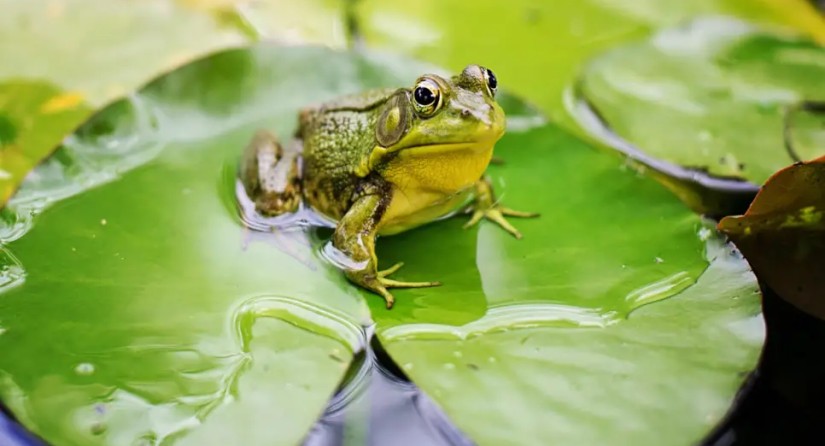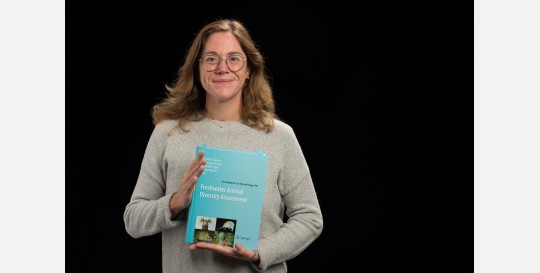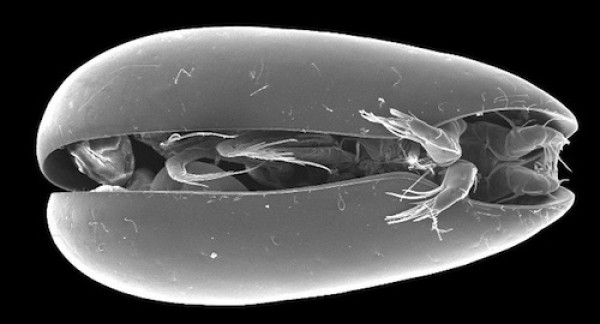infraFADA - Upgrading the taxonomic backbone of global freshwater animal biodiversity research infrastructures
In progress
01.04.23 → 31.12.26

News
FADA and WoRMS Announce a Renewed Collaboration
The Freshwater Animal Diversity Assessment Initiative is pleased to announce a renewed start and partnership with the World Register of Marine Species (WoRMS) managed by the Flanders Marine Institute (VLIZ).

Last year, BELSPO – the (Belgian) Federal Public Planning Service Science Policy – has granted the re-instatement of the FADA expert consortium and the FADA database, under the project ‘Upgrading the taxonomic backbone of global freshwater animal biodiversity research infrastructures’ (InfraFADA). This project is a collaboration between the Royal Belgian Institute of Natural Sciences (RBINS, Belgium, home of FADA) and BOKU University (Vienna, Austria).
As FADA and WoRMS have collaborated in the past, this renewed start was an excellent opportunity to renew the WoRMS-FADA MoU, which dated already from 2017, and was linked to the previous BELSPO-AquaRES project.
This renewed collaboration aims to enhance data exchange between FADA and WoRMS databases, enabling better development and sharing of critical freshwater biodiversity information. WoRMS will provide access to FADA to integrate selected freshwater data into its systems. Conversely, FADA will allow VLIZ to use the collected taxonomic information within the WoRMS environment.
The data collections consist of authoritative taxonomic data curated by international experts and contribute to initiatives such as the Catalogue of Life (COL), the Global Biodiversity Information Facility (GBIF), and e-Science initiatives like LifeWatch. Most of these initiatives rely on a wide array of specialists’ contributions to independent checklists and require extensive interactions with a broad expert network. Given the potential overlap in taxonomic specialists and the complex nature of the data, exchanging expertise and data among these initiatives is highly beneficial for all parties involved.
This collaboration represents a significant advancement in the management and protection of aquatic biodiversity. By combining expertise, this partnership will ensure high-quality taxonomic biodiversity data in open access, essential for scientific and policy applications, and promoting sustainable diversity governance.
The renewed MoU and FADA-WoRMS partnership also contribute to LifeWatch and the LifeWatch Species Information Backbone. LifeWatch is the E-Science European Infrastructure for Biodiversity and Ecosystem Research, a distributed virtual laboratory, which is used for different aspects of biodiversity research. The Species Information Backbone of LifeWatch aims to bring together taxonomic and species-related data, to fill knowledge gaps and to avoid duplication of efforts.
About infraFADA
History of FADA
The initial FADA project emerged more than 20 years ago in the context of the international decade "Water for Life". One of the major challenges was to provide a global assessment of freshwater animal biodiversity to help define conservation strategies and priorities.
The initial FADA project started in September 2002 and ended in June 2003. It consisted of the first approximate global assessment of freshwater animal biodiversity based on existing databases, published reviews, and scientific expertise. The objective was to produce a preliminary discussion document that mainly identified gaps in our knowledge and could be used for discussion. This study identified c 100,000 known freshwater animal species and resulted in a paper in 2005:
LÉVÊQUE, C., É. V. BALIAN, K. MARTÉNS 2005. An assessment of animal species diversity in continental waters. Hydrobiologia 542: 39-67.
A second phase started in March 2005 and was carried out until 2008. The objective was to implement a more complete review of animal diversity in freshwaters. About 60 leading taxonomists were involved in assembling a team of close to 150 experts who had to gather information globally on species and generic diversity for each animal group, as well as zoogeographical distribution and endemicity.
These preliminary results identified more than 125000 species and more than 11000 genera. These results were published in 59 chapters of a special issue of the international journal Hydrobiologia.
BALIAN, E., C. LÉVÊQUE, H. SEGERS & K. MARTENS (Eds .), 2008. Freshwater Animal Diversity Assessment. Hydrobiologia 595: 637 pp
The underlying species lists can be browsed and searched online in the FADA database.
This first assessment highlighted gaps in the basic knowledge of freshwater animal biodiversity richness at continental and global scales. Some groups were being less studied and data on their diversity and distribution was more scarce than for others. Furthermore, the freshwater fauna of certain zoogeographic regions was far less studied than others.


General aim of the infraFADA project
infraFADA aims to provide updated global taxonomic lists (species, genera) on freshwater animals collated and curated by taxonomic experts. The global Freshwater Animal Diversity Assessment (FADA) checklists will be made available to the public in open access and can be used by scientists or different stakeholders. They will serve as taxonomic backbone for a variety of global biodiversity infrastructures.
Project objectives
Objective 1 – CONSORTIUM: To rebuild the global FADA consortium of taxonomic experts for the different aquatic animal groups as well as to update the FADA checklists.
Objective 2 – TOOLS: To develop an online taxa information management system (FADAtims) to allow FADA experts to curate, maintain, and publish their species lists as well as to make these lists available to everyone and interoperable with other (global) infrastructures.
Objective 3 – DATA EXCHANGE: To provide the FADA species lists as the taxonomic backbone to international research infrastructures including GBIF, Catalogue of Life, and FIP using state-of-the-art standards and following FAIR principles.
Objective 4 – PUBLICATIONS: To publish reference taxa lists with associated (meta-) data papers in scientific journals and the Freshwater Metadata Journal as well as to involve the FADA taxonomic expert community in publishing an update of the highly cited FADA Hydrobiologia 2008 volume.
Objective 5 – OUTREACH: To organise outreach activities for potential users, such as organisations performing monitoring activities for the Éuropean Water Framework Directive (WFD), but also to the general public to demonstrate the continuous relevance of taxonomic research.
Summarizing text
Keywords: aquatic biodiversity; taxonomy; web services; taxonomic backbone; FAIR principles.
Although unfrozen freshwater covers less than one percent of the Earth’s surface, ten percent of all animals occur only in freshwaters. This discrepancy, where biodiversity in freshwater is one or two order(s) of magnitude higher than what can be expected from the surface coverage on the planet, is known as the “paradox of freshwater” (Le ve que et al., 2005). However, freshwaters are not only unusually rich in biodiversity, but they are also among the most threatened ecosystems worldwide, because of human impacts and resulting climate change, with their biodiversity declining much faster than in the marine or terrestrial realm.
Several virtual research infrastructures, such as the Global Biodiversity Information Facility (GBIF), document the richness and distribution of extant freshwater biodiversity. However, such global data repositories require reliable taxonomic backbones. The current Freshwater Animal Diversity Assessment (FADA) – collated and published in 2008 – comprises an extensive set of global taxa lists for freshwater animal groups (125,530 described species and 11,388 genera). However, taxonomy is a living scientific discipline where new taxa are being described and existing taxa are being placed in new taxonomic positions. Therefore, after one and a half decades of relative inactivity, FADA needs to be upgraded, both technically and with regard to content, so that it can serve as an up-to-date freshwater animal taxonomic backbone.
infraFADA, a three-year project within the BELSPO (Belgian Science Policy) call INFRA-FED, will develop FADA into a research infrastructure that will enable more and better research and understanding of freshwater biodiversity by developing, using, and implementing new and innovative methods, and by going beyond the state-of-the-art in this area. In order to fulfill these aims, infraFADA has five objectives.
The first objective is to rebuild the FADA consortium of taxonomic experts. Several experts from the extant consortium have already confirmed that they are willing to continue the work for FADA. Several others, however, meanwhile have retired or have other commitments. These experts will have to be replaced. RBINS will coordinate the rebuilding of the expert consortium. The experts will be asked to update the taxa list for their aquatic animal group, which will then be fed into the FADA database.
As second objective, infraFADA will develop an online taxa information management system (FADAtims) which will allow the FADA experts to curate, maintain, and publish their taxa lists, and which will make these lists available to all potential users and interoperable with other (global) data infrastructures. This work will be done by subcontractor BOKU (Vienna), together with the company Kartoza and the coordinating institute RBINS. As soon as FADAtims is operational, the FADA experts will be able to enter new taxa or insert new taxonomic decisions for their group on an ad hoc basis, and without further technical intervention.
The third objective builds on the previous two and will link the FADA taxa lists as the taxonomic backbone to international research infrastructures such as GBIF, CoL, and FIP. In addition, infraFADA will contact other international initiatives and networks dealing with freshwater taxonomic data, and check if the FADA taxa lists can be useful for them. Examples are WoRMS, DISSCo, IUCN, eBIOAtlas, and various initiatives within the LifeWatch consortium as well as ongoing and future infrastructure research projects.
Objective 4 deals with the publication of the FADA data. It is envisaged to publish reference taxa lists including analyses with associated (meta-) data papers in scientific journals and in the Freshwater Metadata Journal, respectively. It is also planned to publish an update of the highly cited FADA Hydrobiologia 2008 volume.
The final objective deals with outreach activities targeting various potential stakeholder communities, such as organisations performing monitoring activities for the Water Framework Directive (WFD), but also to the general public. This will in the first place be done by the publication of the taxa lists on the FADA website and on ChecklistBank as well as through social media, the popular FIP Freshwater Blog, and news items on other websites (SIL, CETAF, SEFS, …). infraFADA will also organise a final project event, back-to-back with another international conference or symposium, where several outreach activities to the general public will be organised.
These objectives will be executed through a set of six work packages and 19 tasks.
The management of infraFADA will be centralised at RBINS but will follow up the different tasks and projected deliverables through a Steering Group (SG) which consists of the PIs of the coordinating institute and the subcontractor, the project manager, and a representation of the FADA expert consortium. Regular meetings of this SG and of the Follow-up Committee will be organised to enable bilateral flows of information. The Follow-up Committee consists of representatives of potential stakeholder organisations which together carry a large critical mass of experience in biodiversity data application and management, which will be useful for the infraFADA project.
There are numerous applications in society balancing nature exploitation and conservation, ensuring its sustainable management, and developing mitigations of climate change. infraFADA will take a visible place in the landscape of publicly available (freshwater) biodiversity data.
Social media
Funding
The Belgian Science Policy (BELSPO)
Partners
The infraFADA is a joint project between the coordinating institute, the Royal Belgian Institute of Natural Sciences (RBINS, Brussels, Belgium) with Koen Martens as promotor, and the University of Natural Resources and Life Sciences, Institute of Hydrobiology and Aquatic Ecosystem Management (BOKU, Vienna, Austria), represented by Astrid Schmidt-Kloiber.
Internal members
External members
- Astrid Schmidt-Kloiber (University of Natural Resources and Life Sciences (BOKU))

infraFADA follow-up committee
- Aaike De Wever Research Institute Nature and Forest (INBO)
- Aline Van Der Werf Belgian Science Policy Office
- Andre Heughebaert Belgian Biodiversity Platform
- Andreas Bruder SUPSI, Institute of Microbiology - Freshwater BON co-chair
- Catherine Sayer IUCN (International Union for Conservation of Nature)
- Daniel Hering University of Duisburg-Essen - – Freshwater Information Platform (FIP) founding member
- Diego Fontaneto National Research Council Italy
- Dimitry Brosens Belgian Biodiversity Platform/ Research Institute for Nature and Forest (INBO)
- Dmitry Schigel Global Biodiversity Information Facility
- Estelle Balian Facilitation for Environmental Action and Learning (FEAL) - FADA founding member
- Helen Dallas Freshwater Research Centre - Freshwater Biodiversity Information System (FBIS) founding member
- Jennifer Lento University of New Brunswick - Freshwater BON co-chair
- Jörg Freyhof Museum für Naturkunde Berlin
- Leen Vandepitte VLIZ Flanders Marine Institute - WoRMS coordinator
- Maria del Mar Sanchez-Montoya Complutense University of Murci
- Matt Yoder University of Illinois - TaxonWorks
- Monika Böhm Indianapolis Zoo
- Olaf Banki Catalogue of Life
- Sonja Jähnig Leibniz-Institute of Freshwater Ecology and Inland Fisheries - Alliance for Freshwater Life (AFL) founding member
- Tobias Musschoot Royal Belgium Institute of Natural Sciences - Belgian Biodiversity Platform
- Maxime Coupremanne Belgian Biodiversity Platform


